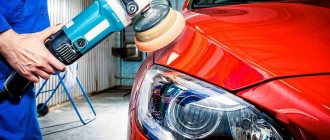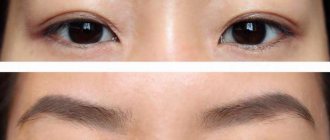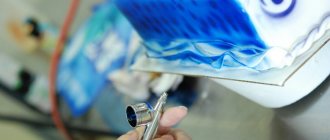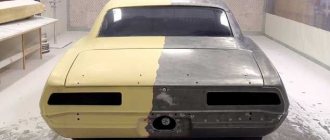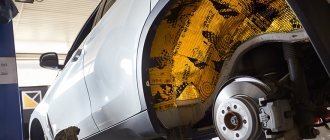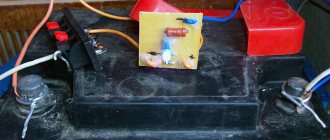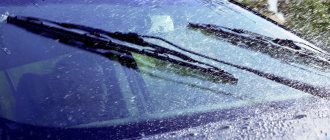Most car enthusiasts know that every car has pros and cons. Thus, among the negative qualities we can highlight the wheel arches. It is this part, or rather its rotting, that is one of the most common problems for motorists. Wheel arches deteriorate on both foreign and domestic cars.
But this “disease” can be cured. For example, modern technology - liquid fender liners - will help provide a high level of protection. In addition to anti-corrosion protection, these compounds also reduce noise from wheels.
The roads in our country are quite aggressive to the external surfaces of cars. In summer, protection from gravel and sand is required. In winter, you can add road reagents to this, which utility workers generously sprinkle on the road surface.
For the wing to completely rust, one square centimeter of surface, which is not protected by anything, is enough. This process does not require much time - a couple of winter months is enough. But liquid fender liners allow you to avoid such troubles.
Anti-corrosion treatment based on bitumen
"Antikor" is a Russian-made product for maximum protection of any surfaces. "Dinitrol" - liquid fender liners. This unique composition is excellent as an anti-corrosion protection and soundproofing material.
Also, the formula in this product allows you to protect surfaces from chips that can form as a result of exposure to gravel or sand.
Compositions with metallized substances are designed to reduce the impact of active chlorine ions. The product is also a type of wheel arch protector. The product line provides maximum protection from any environmental influences.
Fighting car rust
It's no secret that road chemicals that I use in winter have a negative impact on the car body. While a foreign car’s body can resist rust for decades, the same cannot be said about Russian cars. Let's talk about what ways there are to eliminate corrosion and subsequently protect the car body from rust. Water also contributes to the appearance of rust, and this is clearly visible in regions with a humid climate. For example, if a VAZ car has not undergone anti-corrosion treatment, then moisture together with road salt can leave rust through in a few years. As soon as it appears a little, it begins to grow rapidly, so it is advised not to delay it, but to immediately get rid of the rust. The whole process is quite labor-intensive and therefore some people decide to simply hide the rust, which is fundamentally wrong. In a year, corrosion will appear again and even more effort will be required to remove it. Body corrosion can be of varying severity, and the greater it is, the more measures will be taken to eliminate it. Video material:
Methods for removing rust on a car body
The easiest way to get rid of rust is with a rust converter.
This substance converts rust into a no longer harmful compound, as a result, there will be no further growth of corrosion. There are a great many cans of such liquid, some write positive reviews, and some do not believe in miracles. Now let’s look at an example where the rust on the car body has been around for several years and has small bulges or pits. First of all, you need to prepare the surface for work, thoroughly clean it of dirt. To remove rust that has small swellings, it should be removed using a metal brush attachment on a drill. It is allowed to use the same rust destroyer at this stage. After this, sand it well with sandpaper (grit from 80 to 100). It is important to make sure that there are no traces of rust at all, otherwise corrosion in this place will develop again. Next, we degrease the surface, for example, with white spirit (acetone will not work, as it corrodes the paintwork of the body). The last stage is anti-corrosion treatment (anti-rust). There are a great variety of such products on the market, and one of them may be epoxy primer. The composition of this product protects well against rust and creates a good base for applying primer or paint. The disadvantages of such products are duration and toxicity. Thus, to obtain a high-quality result, it takes at least 12 hours. And the last, in my opinion, is the best way to remove rust. This is a method based on electrochemical processes. Unlike liquid anti-corrosion agents, this method requires tens of times less time. The method based on an electrolytic solution of zinc salts is currently considered the most reliable in the fight against corrosion. The base is zinc, which settles on the metal and prevents rust from reappearing. Has everyone heard about a galvanized body that does not rust? This set is called “Zinkor-Auto”, which includes a solution for degreasing and removing rust, as well as a solution for applying a protective coating. When working with zinc preparations, you first need to remove rust from a selected area of the body, and then treat it with a cotton swab soaked in the solution, which is connected by wire to the battery. As a result of exposure to electricity, zinc particles settle on the body, and the treated area becomes gray. xn--2111-43da1a8c.xn--p1ai
Wax compounds
This group is distinguished by its lack of color. If we compare them with bitumen mixtures, wax products are characterized by increased fluidity. They are great for applying to visible areas of the body. In addition, wax-based mixtures are more resistant to frost.
Among these products, we can distinguish compositions with the addition of bitumen. They are ideal for processing wheel arches. Since the density of such liquids is much less than bitumen, all work can be carried out under significantly lower pressure. As a result, the efficiency of such processing is much higher.
New technologies
These liquid fender liners are distinguished by their unique and modern formula. It allows product molecules to penetrate the metal. Water is released much more efficiently with the help of such compositions.
One of these drugs is “Rust-Stop”. It can be applied to any type of car surface, even if they have been in use for quite a long time.
It is very easy to apply this coating. After a regular wash, liquid fender liners in cans are easily and conveniently applied to the required area. But with all the advantages of these protective coatings, there is one small drawback - a weak sound insulation effect.
What to choose for your car?
Each part of the car body must be treated with the means that are designed to effectively solve the problem.
When completely dry, bituminous mixtures produce a film that is somewhat reminiscent of rubber. It guarantees excellent protection against road gravel and sand. The level of noise insulation is also quite high. These liquid fender liners are ideal for processing wheel arches. After all, these surfaces need protection more than others, and the level of vibration there is noticeably higher.
Wax compositions are transparent and penetrate perfectly into the most inaccessible areas. They are best used for body parts.
Oil-based products provide a high level of protection for cars with long mileage. This composition perfectly fills various microcracks in the metal of the bottom. This allows you to significantly extend the life of the car.
Anti-rust agent for cars - anti-corrosion materials for cars
Anti-corrosion treatment is the most important tool to ensure long-lasting vehicle service. If any problems occur with the engine, gearbox, or peripherals, this can be fixed with a fairly small budget, but a rusty body will require either huge investments or simply selling the car before it completely falls apart. If rust on the body has already begun to spread, the car will need urgent repairs. The process of corrosion spreading throughout the car body is quite fast, so without taking measures, you will soon have nothing to drive. However, every car owner has his own opinion on this matter; many believe that corrosion on the body is inevitable, and there is no point in panicking when it appears.
A high-quality rust remover for your car body is the way out of the situation. You can use anti-corrosion treatment to prevent, solve the problem, and also prevent the spread of rust throughout the car body. Therefore, you can find dozens and even hundreds of types of products for removing or preventing corrosion on store shelves. It is interesting that in most cases, car owners use the simplest and cheapest means, choosing far from the most suitable options for mixtures and materials in their case. Remember that a high-quality product will not be incredibly cheap, will not dump competitors’ prices and will offer the most profitable options for processing the body of your car with a guarantee of no corrosion.
How to choose the right anti-corrosion agent for your car?
There are many criteria that should be taken into account when choosing an anti-corrosion agent or special anti-rust treatment. There are several dozen subtypes of these materials that are used in different situations. You should also remember the general rules for selecting any material for a car and the specific requirements of a particular situation. It all depends on what stage of body corrosion in your car needs to be treated. Perhaps you just want to carry out preventive maintenance and spray an effective anti-rust product without unnecessary effort on the inside of body parts. The main criteria for choosing materials are as follows:
- price - you should not give preference to the cheapest options for anti-corrosion treatment, but you should not buy overly expensive mixtures either;
- brand - it is better to purchase a product from a well-known manufacturer, which is guaranteed to work and will help perform the necessary tasks;
- scope of use - there are liquids for anti-corrosion treatment with specific application features;
- type of metal and other body coatings - you need to take into account the features of your car’s body in order to buy an effective liquid;
- method of applying the material - a lot depends on how you will apply the layer of anti-corrosion material;
- condition of the body at the time of application - many car owners treat the body before painting, which expands the choice of effective products.
As you can see, there are many criteria that allow you to choose an effective and inexpensive means of protecting the body from corrosion. It is worth remembering that before applying any anticorrosion agent, it is necessary to properly treat the body, remove rust and the beginnings of other metal damage. A layer of anti-corrosion coating must protect the body for a long time, otherwise, at the first damage to this coating, the car will begin to show problems with the body. There are different types of anti-corrosion treatment that are actively used by car owners these days. Let's talk in more detail about some of them.
Anti-corrosion treatment of the car underbody
The lower part of the car is a place where we rarely look. It is this place that is subject to the constant influence of dirt, moisture and other destroyers. Therefore, immediately after purchasing a car, you should carry out high-quality anti-corrosion treatment on the bottom of the car, as well as on the wheel arches. This will help preserve the car and extend its service life. To perform such anti-corrosion treatment, various materials and tools are used:
- various types of mastics that are designed to preserve the body and overcome any influences on the metal from the open environment;
- other types of bituminous materials applied to the body under a certain pressure to ensure a fairly high quality coating;
- special materials for anti-corrosion treatment of the body, such as Dinitrol and other bitumen products with special plasticizers;
- so-called liquid fender liners for processing arches, which are actively used for application directly to the bottom of the car;
- special films and adhesive materials for preserving the body, which over time eat into the metal (at least that’s what the manufacturers say);
- other various options for miracle products that can protect a car from corrosion for centuries.
We recommend using two types of treatment for car underbody. This is a bitumen mastic that is applied to clean metal or an old worn-out layer of mastic, and can also be sprayed using a spray gun and a special installation for applying anti-corrosion material. Excellent processing is only possible if all areas of the fender liner and bottom are covered, and there is no bare metal left that could become the beginning of the development of corrosion processes.
Body anticorrosive on internal parts of parts
Another type of anti-corrosion treatment is the filling of body parts along the internal planes with various materials that are also of bitumen origin. This can be either ordinary mastic, diluted with a solvent for a thinner layer, or a special prepared bitumen mixture that completely covers the internal parts of the body and acts as a preservation of metal parts. There will be no corrosion from the inside. Such processing can be performed using the following sequence:
- dismantling the body plastics on the doors in the cabin, possibly removing the front panel for additional anticorrosive protection;
- exposure of metal parts in the trunk and under the hood, assessment of the quality of their condition;
- use of special means to supply bitumen materials under pressure and obtain optimal pouring results;
- applying a special material on top of the mastic, which will prevent it from leaking into the cracks between the metal and plastic of the interior;
- complete drying of the top layer and assembly of all previously disassembled parts for further operation of the machine.
Of course, it is much more logical to simply outsource this work to specialists. You can bring your car to a service station that offers anti-corrosion car coating services and order the necessary anti-corrosion options. After a certain time, all you have to do is come to the service station and evaluate the finished result. Of course, this option for anti-corrosion treatment of the body is much more expensive and is one of the most effective, but only if you choose the right company that will deal with this issue. The process of anti-corrosion treatment of a car is shown in the following video:
Let's sum it up
If you want your car to last long enough and not get corrosion and through holes in the body after a couple of years of operation, you should have your car treated immediately after purchase. If we are talking about a used car, the anticorrosive treatment must be performed literally on the day of purchase. Expensive new cars are treated at the factory, but the anti-corrosion coating on them lasts for 2-3 years. Cheap new cars from budget segments have quite big problems with body processing. Often, body parts are not processed in any way and are not properly protected from corrosion.
Therefore, even after purchasing a new car, it may be necessary to carry out anti-corrosion treatment on body parts. Although this process is specific, difficult and often expensive, it will add years to the life of your car, which will save a lot of money on body repairs. You should also remember that used cars with perfect bodywork sell for much more, so your investment will pay off exactly at the moment when you decide to sell or exchange the car for another one. Have you done anticorrosive treatment in your car in the last 2-3 years?
avto-flot.ru
Making liquid fenders with your own hands
Branded products have a certain, not always justified cost. You can achieve almost the same effect for a lower price. To make an anti-corrosion agent at home, you need to follow a few simple steps.
The car should be placed on a lift, overpass or pit. If all this is not available, then a high jack will help. Then the wheels and mudguards are removed, of course, if there are any.
The wheel arches should be washed very thoroughly and allowed to dry perfectly. A heated garage is best for this. If other mixtures were previously applied to the surface, it is better to remove them, because do-it-yourself liquid fender liners may not “lay down” properly. It is recommended to close the brake discs.
Now apply the first layer of anti-corrosion compound to the surfaces of the arches. Once it's completely dry, it's time to apply a second one. Bitumen mastic is perfect for this. Make sure that it is applied to the surface as evenly as possible.
Once the second coat has completely dried, you can begin the final coat. It is best to use a product with anti-corrosion rubber. It’s even better if the application is done by spraying the composition over the surface. This will fill microcracks in the mastic.
The last stage requires waiting. The main rule here is no rush. Let all three layers dry completely. After completing the work, arches that are treated in this way will be no worse protected than if you used liquid fender liners in cans.
What qualities should anti-corrosion coatings have?
Anti-corrosion compounds for external and internal body treatment are divided into three main classes:
- liquid oil, paraffin for internal surface treatment;
- bituminous materials for anti-corrosion protection;
- wax universal anticorrosion agents.
The quality of the material depends on the following indicators:
- Environmentally friendly. The product should not cause allergic reactions.
- Plastic. The composition must remain elastic throughout the entire period of operation and maintain tightness during body deformations during vehicle operation.
- Heat resistance. At elevated temperatures, liquid anticorrosives should not drain, and bitumen mastics should not crack or peel off at sub-zero temperatures.
- Resistance to mechanical damage. Anticorrosive for the bottom should create a durable layer that does not deform and retains its protective properties during constant impacts of gravel.
- Preservation of corrosion. The anticorrosive composition should include corrosion inhibitors and special additives that preserve existing rust. This parameter is especially relevant when processing the underbody of 5-7 year old cars. On such machines, it is difficult for craftsmen to strip the part down to bare metal.
It is recommended to treat the outer part of the bottom with elastic hard anticorrosives, mastics based on bitumen and rubber resins. Compositions for external protection, in addition to anti-corrosion properties, provide additional anti-gravel protection and noise insulation. They are applied using a brush, spray or gun.
Internal surfaces are treated with liquid products based on oil, paraffin or wax. The compositions are sprayed with aerosols and applied with brushes. Thanks to their oil base, they completely fill the hidden pockets of the bottom, and corrosion inhibitors preserve the hot spots.
The most common and productive anticorrosion agents for external and internal treatment of the bottom:
- Slate mastic. It is used for external coating of the bottom and wheel arches; after drying, it forms a bitumen film with complete waterproofing.
- Anticorrosion agents based on rubber-bitumen compounds are used to treat the external parts of the bottom and are considered the best in the price/quality segment. Resistant to low temperatures, provide a long service life, mileage of more than 50,000 km if applied correctly.
- Anticorrosion agents based on bitumen and rubber are universal products; they are applied to the external parts of the body and internal pockets.
- Liquid anticorrosive agents such as Moville often have aerosol packaging and are used to treat the internal cavities of the body: the threshold box, the bottom.
User reviews
One of the car owners spoke very flatteringly about this technology. So, it was decided to install protection for the wheel arches on his wife’s Lanos. But there was no desire to make holes in the body for fastenings for plastic protection.
We decided to use this new technology. The choice was made in favor of Prim products. Liquid fender liners from this company are considered one of the best. The product was applied very quickly. This protective layer is practically invisible. After treatment, the car has been driven on various roads, and the protective layer looks as if it were brand new.
If you want silence
For those car enthusiasts who want to reduce driving noise, these protective materials are perfect. Such products combine excellent anti-corrosion properties and sound insulation functions.
For example, those who have used liquid fender liners have simply rave reviews about the degree of sound insulation. So, you can practically not hear the stones from the road, which previously flew off and thuddedly hit the fender liner.
Some motorists used various bitumen-based mastics instead of factory products.
So, we found out what reviews and characteristics of automotive liquid fender liners are. Have a nice trip! No nail, no rod!
Many owners, wanting to protect their car from corrosion, cause irreparable damage to the body. Let's consider what kind of wheel arch protection will increase the level of comfort in the cabin and will not provoke rusting of the body.
How to coat the underbody of a car against corrosion? Considering the right options
The problem of how to coat the underbody of a car will never lose its relevance. As long as you don’t see it, your heart doesn’t hurt, that’s understandable. But knowing how vulnerable the bottom is, and not wanting to suddenly rattle along with the seat on the asphalt, you will inevitably have to worry about the condition of the “underwear”. And the concern is justified. Not only are many modern cars not stored in garages, but most sit outside for life and are exposed to all winds, snow and rain. You can get used to bad roads and come to terms with the “flying off” of the surface, which regularly peels off the bottom. In winter, the bottoms of cars take another blow: anti-ice preparations that corrode metal seem to be more successful than ice. Without a doubt, the bottom of the hull diligently resists enemies. But scratches and potholes do their job: rust eats away at it every day. How to coat the underbody of a car against corrosion depends greatly on its condition. Theoretically, all options can be divided into three groups. Depending on the purpose and condition of the case, three processing options can be offered. Passive protection All kinds of mastics are used for it. They are most often based on bitumen, but resins or rubber can also be used. The auxiliary components are graphite and all kinds of fibrous fillers. According to the rules, before directly applying the protection, it is necessary to wash the bottom and apply a layer of primer to it, and heat the mastic itself to increase fluidity. The protection is applied in several layers, with some space between them to allow the previous one to set. This method has a number of disadvantages:
- If the bottom is not sufficiently dried, a certain amount of moisture remains under the mastic layer, which continues its destructive work;
- After some time, the mastic dries out and cracks. In them, corrosion develops much more intensely than on completely open surfaces.
Many people apply a mastic layer very thickly, believing that this increases its reliability. However, such a coating begins to sag under its own weight; unable to withstand the load, pieces fall off, forming pockets into which corrosion bites. Active defense Its prominent representative is Movil. It is more attractive than mastic for the following reasons:
- no cleaning of the previous protection is required - Movil is “friendly” with almost all brands of anti-corrosion and successfully cooperates with them, compacting the loosened and cracked mass;
- The product contains an inhibitor, thanks to which it eliminates incipient rust spots. That is, neither inspection of the bottom, nor its cleaning, nor subsequent priming is needed;
- The composition contains special additives that displace residual moisture. If the bottom has not been thoroughly dried, it doesn’t matter; corrosion will still not gain access to it.
The only drawback of such preparations (usually they are produced in sprays) is that they corrode the rubber. That is, you need to be careful that the composition does not get on the gaskets - otherwise they will have to be changed. Transformation If the bottom is quite heavily affected by rust, you will have to resort to strong medications. Modern industry has made the task much easier, but some effort is still required. And you won’t be able to do it in just one approach. The following actions will need to be taken:
- wash and degrease the bottom;
- dry it - either with a hair dryer, or naturally, with time spent waiting;
- treat the bottom with a rust converter. Here the chemical industry offers the widest choice. You can inquire about the characteristics of all the drugs, you can take the path of least resistance and buy regular Omega-1 - this is what many motorists regularly use to “fight rust” on the bottom;
- wait until it takes effect, then remove the resulting foam;
- to avoid the regularity of such “gymnastics”, treat the bottom of the car with either mastic or something like Moville.
In many cases, choosing just one thing is not enough.
When choosing what to coat the underbody of a car against corrosion, you often have to combine different methods. The main thing is not to forget to look underneath. If you take things to the extreme and start the process, none of the “soft” methods may help you. We'll have to resort to drastic measures - digesting the bottom. AutoFlit.ru
Methods
For most drivers, mud flaps are rubber flaps that are installed behind the wheels near the bottom of the front fender and rear bumper. If we are talking about a car body, then a mudguard is usually called a metal casing that connects the spar, the engine shield and the wings in the nose (the shock-absorbing strut cup is part of the mudguard). In the rear part there is a mudguard - the wheel well of the body. The protection of these body elements will be discussed.
The car owner has only 2 ways to protect wheel arches:
- installation of fender liners. The plastic casing is attached to the wings and the internal cavity of the mudguards;
- liquid protection. The arch is treated with a special anti-gravel material based on bitumen and anti-corrosion components. For application, use a special gun that sprays a liquid mass, or a brush. After drying, a dense, damping surface is formed on the body, which has noise and vibration insulation properties.
Sound insulation deserves special attention. Due to vibrations from driving over uneven surfaces and the rolling noise of tires, the cavities of the mudguards are quite vibration- and noise-laden areas. Water, dirt and large stones flying from under the wheels, hitting the metal part of the body, resonate, which leads to the transfer of noise into the car interior. Good noise insulation protection of the wheel arches significantly increases the level of comfort.
Which is better
If we consider plastic fender liners and liquid protection separately, it is difficult to choose the best method. If there are factory places for attaching protection, as well as corresponding plastic products, it is better to give preference to fender liners. They are more durable in use. To install rubber mud flaps, you will not need to drill into the body, which is a huge advantage.
If there are no standard places for fastening in the wings, and the owner does not want to bother installing lockers without screws, then it is better to choose liquid sound insulation. In terms of the level of transmitted noise, these methods of protection are approximately the same, but the disadvantage of liquid fender liners is their fragility. Constant impacts of stones, dirt, moisture, temperature changes and vibrations of the body lead to delamination of the material. As practice shows, even high-quality processing must be repeated every 2-3 years.
The best way is combined protection with preliminary sound insulation. After applying noise and vibration insulation, the cavity is treated with liquid mastic. And only then the fender liner is installed.
Selection of lockers, mastic, sound insulation
Guidelines when choosing fender liners:
- thickness. Products that are too thin are damaged faster and are more susceptible to deformation in the hot season;
- elasticity. Lockers are made of ABS or PP plastic. The latter option is more elastic and therefore often more durable. But even with the same labeling, you can feel the difference between manufacturers. You should not buy products that are too hard, as the material will become completely hard in the cold, which can cause cracking;
- presence of stiffeners;
- holes for standard fasteners, if provided.
The choice of manufacturers is huge (API, ASAM, SA, FLORIMEX, GORDON, KLOKKERHOLM, POLCAR, SAT and many others). You need to identify manufacturers offering fender liners for your car model, and then ask about the operating experience of other car owners. One of the main factors, which, unfortunately, can only be checked during installation, is the coincidence of the body moldings with the shape of the fender liner. This will allow protection without distortion and tightly close all cavities.
Mastic, soundproofing materials
Previously, we have already considered the application of liquid sound insulation, on top of which lockers can be installed. To form liquid fender liners, you can use Dinitrol 479. As a pre-treatment before installing the lockers, you can use anti-corrosion mastic with a noise-absorbing effect from APP, Terotex, Schwarz or other manufacturers.
The following are used as sheet insulation:
- base layer of vibration-absorbing composition with a thickness of 2 mm;
- soundproofing material.
There are now a huge variety of material models, as well as manufacturers (Shumoff, STP, Vikar, etc.). Therefore, when choosing, you should focus on the price, as well as the thickness of the final coating. The noise-insulating “sandwich” should not interfere with the installation of lockers. It is advisable to buy material with an adhesive layer based on mastic rather than water-soluble adhesives.
Manufacturers
There are quite a few manufacturers of liquid fender liners on the market:
- Nova is a manufacturer of liquid lockers that is quite widespread on the market. The manufacturer promises a 5-year warranty, but you should not delay this and update the material after 3 years. The cost of production will be about 3,500 rubles per set for all body arches. Application occurs using a sprayer on treated arches. The advantages of this manufacturer include good anti-corrosion performance, however, such a product is not suitable as a remedy against acoustic noise. Since the manufacturer is a domestic company, in many cities there are specialized services for processing arches and other body parts in compliance with all norms and standards (and, importantly, maintaining the manufacturer’s warranty);
- Hi-gear – American manufacturer of liquid fender liners. The company is well known in the domestic market for its quality. According to its characteristics, it is one of the leaders in such indicators as: - durability of the material, sound insulation properties. The network of specialized services is also quite well maintained. Complete treatment of car arches using such a product while maintaining the warranty will cost 10-12 thousand rubles. The manufacturer guarantees the preservation of the properties of the material for 6 years. During normal use, the composition can retain these properties throughout its entire service life;
- Henkel is a German manufacturer of auto chemicals. They are not as popular on the market as the two previous companies, but in terms of their properties, the products are in no way inferior to leading manufacturers. To treat the arches you will need 8 500 ml cans. The cost of one cylinder averages about 300 rubles. The application method is the same as for all types - the product is applied to the arches using a spray bottle.
On video, liquid fender liners for wheel arches:
Market leaders in Russia
It’s worth mentioning the undisputed market leaders – Astrochem and Dinitrol:
- Astrokhim is a domestic manufacturer of liquid fender liners. In terms of its characteristics, it is only slightly inferior to its direct competitor (worse noise insulation properties). The cost of one can will be about 400 rubles. Manufacturer's warranty for preservation of properties is 8 years;
- Dinitrol479– Swedish manufacturer of automotive chemicals. In the domestic market, the products of this company are the undisputed leaders. For most indicators (corrosion resistance and noise insulation qualities), the product occupies the first positions according to the results of independent ratings. The cost of one can of Dinitrol 479 is about 700 rubles.
Preparation, sound insulation
Protecting the arches begins with washing the inside of the mudguard and thoroughly drying it. Then the entire surface is degreased. Option for good sound insulation of wheel arches:
- A vibration-absorbing layer is glued onto the entire surface of the mudguard, covered by the locker you purchased (for example, Shumoff L3 or M3. It needs to be heated before pasting). The sheets are rolled tightly with a metal roller. In this case, the standard anti-gravel coating does not need to be removed;
- Mastic is applied on top with a brush or spray. If desired, you can put it in 2-3 layers, but at the same time, allow 10-15 minutes of drying between layers. at a temperature of +20ºС;
- plastic lockers are covered with noise-absorbing material (for example, Shumoff Germeton A15). Also at this stage, soundproofing sheets based on foam rubber can be used (as an option - Shumoff Comfort 6).
Correct installation of lockers
Many cars have factory mounting locations for fender liners. Special plastic “bugs” are used as fastening elements. The use of self-tapping screws is permissible when attaching lockers to plastic elements (decorative threshold trim, bumpers). If processed correctly, self-tapping screws can be used as fasteners at the bottom of the internal cavity of the mudguard.
Never use self-tapping screws to attach the fender liner to the edge of the wing. Moisture is trapped between the plastic casing and the wing. In the place where the metal is exposed, rusting will inevitably begin, which, moving upward, will destroy the paintwork.
When you can't do without self-tapping screws
If another installation method is not possible or if holes have already been drilled in the wing before you, the metal must be protected. If there are no traces of rye in the area where the paintwork is damaged, prime the area with epoxy primer and paint it with acrylic paint from a spray can. Rusted areas must first be cleaned and treated with a rust converter. After drying, treat the inner cavity of the wing and the edge adjacent to the fender liner with anti-corrosion mastic (for example, Movilya). Also soak the self-tapping screw in mastic before screwing it in.
Useful solutions
Often, protecting wheel arches with fender liners can only do harm. Vibrations from a poorly secured product damage the paintwork in the plane of contact with the wing. There are two ways to deal with this:
- The edge of the locker is trimmed, and a special seal is put on it. The soft rubber coating fits tightly to the wing and does not scratch the paint;
- use of body sealant. It is applied where the plastic adheres to the body. Promotes waterproofing, which is important for both paintwork and laminated sound insulation. The sealant not only performs a waterproofing function, but also acts as an additional fastener. After drying, it remains elastic and therefore does not crack.
UNDER THE WING
The most expensive part of a passenger car is the body. Therefore, everyone strives to protect it and first of all thinks about the wheel arches - the most vulnerable places to corrosion. After all, a hail of stones and sand from under the tires can destroy the protective coating in a short time, and a clean field of metal on the inner (partly also outer) side of the wings will be exposed to rust. Fender liners are the right way to protect them, but which ones to choose? Andrey SIDOROV thinks about this.
In the pre-Zhiguli era, this problem was not so acute. Apparently, the iron was thicker, and there was less salt on the roads, and the annual mileage of 10 thousand km was considered quite large (not like today). Anti-corrosion treatment in those days was simple and unsophisticated, as was the object of its application. On a hot summer day, a bucket of a mixture of petroleum products - nigrol, "working off" or fluff lubricant - was placed on a fire or blowtorch and heated to make it thinner. Using a spray bottle, a brush, or at worst, a broom, the brew was applied to the bottom. After a short run along a dusty dirt road, the treatment was considered complete.
With the advent of thin-walled Lada cars, such protection became clearly insufficient, which gave rise to Movil, rubber-bitumen, epoxy, shale and other preparations. But under the onslaught of sand and rubble from under the wheels, even the best of them could not withstand more than two years, after which they had to treat the rust-affected areas again. This situation has continued to this day; moreover, it has worsened. And not only because of the poor quality of factory paint and anti-corrosion compounds (a topic for a separate discussion), but also because of the salt solutions that are abundantly watered on the roads. Therefore, additional treatment of body parts with anticorrosive agents before installing fender liners is still required.
Curly aluminum or galvanized steel sheets framed by a rubber seal (usually complete with a mudguard), which were common in the past, did a very good job of protecting the wheel arches. Nowadays, such fender liners are becoming less and less common - over the years of operation, their shortcomings have also become apparent. Due to the low rigidity of the flat sheet, its upper part rubs against the wing with a sealant and gradually scrapes off the factory coating, exposing the metal. In addition, aluminum and steel form an electrochemical couple, and the fender liners are actively destroyed at the points of their contact. Well, what in return?
The advantages of cup-shaped fender liners made of fiberglass, polyethylene and other similar materials are undoubted. They repeat the internal configuration of the arches - which means that wheels of all sizes allowed by the factory will not touch the fender liners even at maximum wheel angles and suspension travel. The best examples of this type not only protect the wheel arches from flying stones, sand, and dirt, but (which is especially important) also provide excellent ventilation even in those areas where there was complete calm without the fender liner. Salty and wet dirt usually clogged there, which ate through the metal in a matter of months. By the way, effective ventilation of the closed cavities of the car, which greatly prolongs the life of the body, is a matter of concern for the car’s designers. Alas, domestic developers either did not take on this task at all (they never got around to it), or simply forgot about it.
What are the requirements for fender liners? They should be easy and simple to install and remove, not impair aerodynamics, not spoil the appearance of the car and, of course, not reduce its safety. There are known cases when a metal sheet fender liner came off and jammed the wheel. This will not happen with plastic fender liners, even of the lowest quality - they will simply fall into pieces.
Having to some extent summarized the experience of operating fender liners from different manufacturers, let’s see what stores and markets offer today, what is worthy of the buyer’s attention and what is not.
As we have already noted, sheet metal fender liners have practically become obsolete. Fiberglass, until recently the most common, is also rare today, and here’s why. Quite durable to the touch and the lightest, they have low impact strength, especially in winter, that is, they do not withstand impacts from stones well and are therefore destroyed. In the cold, the edges crack and begin to fringe. They need repairs with epoxy glue almost every year. It is not difficult to distinguish them from the general range of analogues. Since they are made of several layers of fiberglass filled with materials based on epoxy resins, intertwined threads of the fabric will certainly protrude on the surface of the fender liner and the edges of its individual pieces will be visible.
Recommendations for selection
Liquid fender liners, which is better? They differ in the material of manufacture, method of application, size and shape. There are front and rear fender liners. They have different shapes, don't confuse them. As a rule, stores offer to buy a set of four lockers at once, but this is not always what the buyer needs. It happens that you need to buy only a pair of rear ones or, in general, one, if it is worn out.
Correct installation of protection is very important. Before installing the lockers, thoroughly clean the body of dirt, sand the surface and degrease it. The arches should be treated with mastic. Do not install lockers on a rusty surface under any circumstances - the body will rot to holes.
The fender liners are fastened with self-tapping screws or special latches are used. If you have purchased fiberglass lockers that are attached using special fasteners, be sure to select the correct product. Fasteners can rub against the body, exposing the metal, which exposes it to corrosion. The locker should fit clearly into the arch.
Fiberglass cannot be soldered and its flexibility is not good enough. The same disadvantages are inherent in ABC plastic. The most popular are lockers made of polyethylene plastic; they do not burst, have various methods of fastening and are considered the most convenient. Although this can be argued. Thanks to modern technologies and new materials, liquid fender liners are becoming more and more popular; they have no analogues. Remember, correctly selected and applied fender liners will extend the life of the car.
Good day to all Friends, Subscribers and just guests! And so I will begin for a long time did not appear and did not write anything here. With the car nothing much happens. There was time and a place and then it started)) for a long time I wanted to do this only all the time it was not enough.
I just want to say if there is a time of about two or three days extra, then it will be interesting to do this. There will be no advertising in this record, but how to properly make an anti-corrosive car and applying liquid wheel liners. I won't write what material is better which one is worse, look as they say, to your taste and wallet. High-quality anticorrosive is not done in one day, do not let anyone in your ears say it to you. Since it is necessary to apply about two to three layers with periodic drying.
This is a purely personal matter for everyone - to do the processing or not. But you should not forget the saying - Miser, pays twice!
And so it turned out to be a free day and the time went to work. For this we need No. 1 Material, - mastic, atigrave with rubber crumb, Movil and push lard No. 2 Pistol for spraying mastic, etc. No. 3 Air compressed (compressor) No. 4 Preferred room No. 5 Elevator or in extreme cases, inspection pit or overpass No. 6 Rags, preferably several blankets or a cover to cover the car No. 7 Curher with a pair of nozzles No. 8 – Escape Hotel No. 9 Vibroplast M1 (or M2). if you make noise locker or fenders It seems that nothing has forgotten what is needed, oh yes, the most important thing is the head and hands))) Before applying or making the anticorrosive it is necessary to wash the bottom thoroughly, wheel arches under water pressure for this you need to use a korher with certain attachments or you can do all this on a car wash for a certain fee. When you grind the car (arches, bottom) we install on the lift we remove the wheels and all plastic (lockers - if they are, take out all the plugs, also had to remove the wiper completely, as under these protections there was no application of anticorrosive there was only one primer !) and dry until completely dry. Preface or why I decided so When I bought the car right away I said that I would not do anticorrosive! ! since I know how to do it, they do not do it qualitatively, but to alter them as if it is not ice, they will not do so qualitatively as you do not do it and will do it for you in a couple three hours and where the eye falls. We ourselves will not do it. When buying a car, my manager, OD. said why you anticorrosive? because the car is already coming from the factory, everything has been done ! In vain, he said so to me)) Well, no, not about that GETTING STARTED When I washed all the arches and lifted it up to the lift and started to shoot everything and see where it was done and where it wasn't, I didn't let down the premonition)) don't believe it yourself. Everything is indicated by arrows
When the car is dry
I got down to business, in places both fatted where there will be liquid wheel arches. The front inner racks near the wing rustled a little. The entire rack does not need to be glued, you must leave places where the water drain connection
External insulation is an additional set of measures to reduce the noise level of the car. Under the external noise insulation refers to the processing of body panels from the street. Such processing is exposed to the places most exposed to noise and vibrations — the engine shield, the bottom and the arched space in the area of the front and rear wings. I want to draw attention to the fact that external insulation is still secondary. It is expedient in the case of work on internal noise insulation or a sufficiently high level of standard noise insulation.
Wheel arches are a place through which one of the most pronounced noises penetrate — noise from the tires during movement, movement of air and soil particles in the inner-arch space, noise from the suspension and reflected waves of engine noise. Not a little, is it? That is why the internal noise insulation pays special attention to the processing of arches, the bottom and engine shield.
